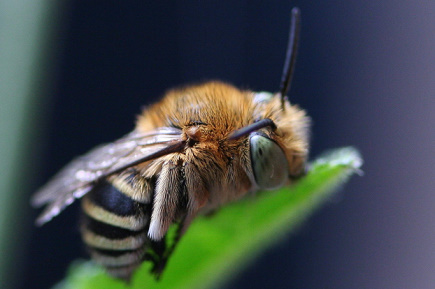An un-bee-lieveable sight
Through my own perseverance and patience, I was lucky to finally take some macro photos of a Blue-Banded bee. And on my birthday too!
Today is my birthday, so I decided to pay my parents a visit late this afternoon.
As per usual I took my camera like any keen photographer would do. One can never be certain of when something photogenic will appear. In times past, I’ve experienced the disappointment of seeing something remarkable and not having my camera there to record it for posterity.
So it was very fortunate that I took my camera today, because I’d hardly set foot in my parents’ garden when I spotted something very interesting indeed. Resting upon a native hibiscus (Hibiscus geranioides) was a tiny solitary Blue-Banded Bee who’d settled-in for the night.
Blue-Banded Bees (Amegilla cingulata) are relatively rare Australian native bees seldom noticed in suburban gardens. Last year I spotted my first ever Blue-Banded Bee, but I’ve seen many since and have developed a keen interest in these beautiful insects.
Because of their rapid flight patterns, I’ve never been able to take a decent photograph of a Blue-Banded Bee. And for all the bees I’d spotted in gardens, I had never seen one resting, as they’re reported to do. Now the situation has changed on both fronts; I’ve seen one resting and have the macro photograph to prove it!

Photographing the Blue-Banded Bee was not easy. The bee was only 1 centimetre long, and the plant that he was sitting on was prone to movement in the breeze. I had to resort to carefully staking the plant in place to prevent its movement, mindful not to disturb the resting bee.
Next I had to set-up my tripod. The plant was positioned at the end of a narrow sideway and at an awkward height, so I had to cramp myself into a tiny corner and contort my body in a very peculiar manner to see the bee through the viewfinder of the camera.
Finally, I had to focus the bee as best I could. Focussing with a macro lens is a precise art with no room for error. It was getting late and the light levels were quite low. But I knew reducing the shutter speed would lead to blurred photos. To compensate, reducing the aperture would reduce the risk of blur, but also reduce the depth-of-focus. Additionally I really wanted to shoot at 100 ISO to keep noise to a minimum. What a fussy photographer I am!
Thankfully, the bee was a patient subject and allowed me to spend 20 minutes taking 89 photographs until I was convinced that I had something worthwhile. And of those 89 shots, 3 were sharply focussed. The magic formulae were an exposure of 1/50 sec, ISO 100 and f/2.8 and 4 seconds at ISO 100 and f/11 respectively for the two pictures shown here. No-one said macro photography was easy, and I am still learning the art.
But I am really happy with the results. After almost a year, I finally have my much -coveted Blue-Banded Bee photos. What a great birthday present!

Comments
5 responses to “An un-bee-lieveable sight”
And it looks so cuddly, too! Until I saw your photos, I had no idea these existed — thanks for the quick nature lesson 🙂
They may look cuddly but they still have a sting! Glad you enjoyed the article 🙂
hey
did u go to NZ and find these bees?
I found these bees in my garden last year and had no idea what it’s called… so i gooled it. I live in Cebu Philippines.
Today they are back!!! August last year was the last time I photograph them.. so I think they only comes out once a year here in Cebu Philippines.